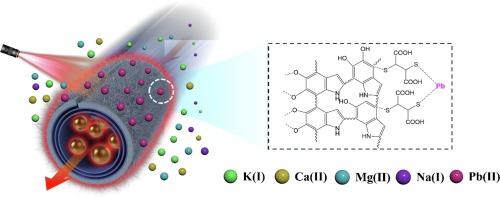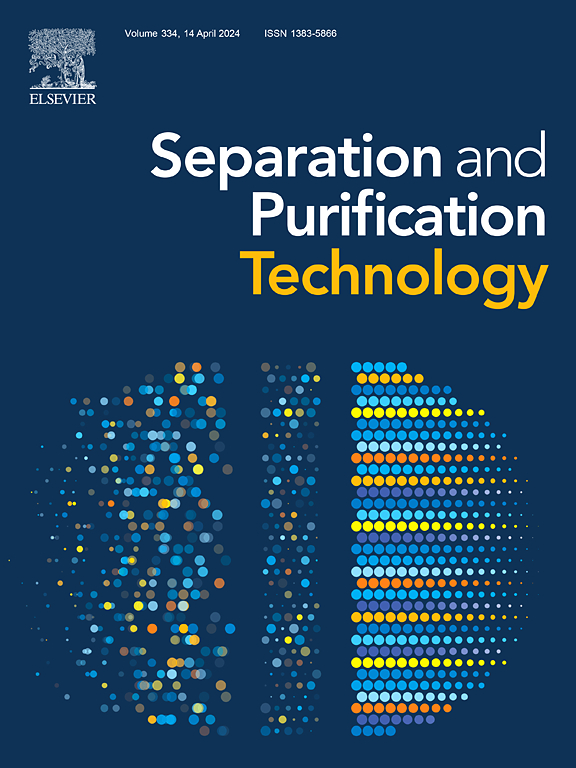Sequential super-assembled nanomotor adsorbents for NIR light-Powered blood lead removal
IF 8.1
1区 工程技术
Q1 ENGINEERING, CHEMICAL
引用次数: 0
Abstract
Hemoperfusion is a common treatment for lead poisoning, where hemoperfusion adsorbents are used to remove lead ions from blood. However, traditional hemoperfusion adsorbents often suffer from limited efficiency and poor biocompatibility, reducing their effectiveness for human use. To address these limitations, we developed a novel photothermal nanomotor adsorbent through a controllable sequential super-assembly strategy. Gold nanoparticles (Au NPs) were incorporated into the nanochannels of halloysite nanotubes (HNTs), followed by modification of the outer HNT surface with polydopamine (PDA) and 2,3-dimercaptosuccinic acid (DMSA), forming Au@HNTs@PDA-DMSA. This nanomotor adsorbent leverages the photothermal properties of Au NPs to achieve self-propulsion via thermophoresis under near-infrared (NIR) light irradiation. The performance of this nanomotor was evaluated for Pb(II) removal in both aqueous solutions and human blood samples, reaching adsorption equilibrium within 20 min and a maximum capacity of 45.980 mg/g. The adsorption kinetics followed a pseudo-second-order model with a high fitting coefficient (R2 = 0.999), and the Langmuir model fit better than the Freundlich model, indicating monolayer adsorption. Notably, when driven by 808 nm NIR light at 1.0 W cm−2, the Au@HNTs@PDA-DMSA nanomotors showed a significantly enhanced adsorption capacity of 151.769 mg/g, improving blood lead removal efficiency by 1.80 times compared to non-irradiated conditions. Furthermore, the addition of sulfhydryl and carboxyl groups from DMSA provided more active sites, leading to a 9.76-fold increase in lead removal compared to passive adsorbents using HNTs. In vitro tests confirmed the excellent biocompatibility and biosafety of the nanomotor adsorbent, achieving a blood lead removal rate of 91.25 %. This advancement overcomes the limitations of traditional lead adsorbents, offering a promising solution for more effective lead detoxification in clinical and environmental settings.

用于近红外光源去除血铅的序贯超组装纳米马达吸附剂
血液灌流是一种常见的铅中毒治疗方法,利用血液灌流吸附剂去除血液中的铅离子。然而,传统的血液灌流吸附剂往往效率有限,生物相容性差,降低了其对人体的有效性。为了解决这些局限性,我们通过可控的顺序超组装策略开发了一种新型光热纳米马达吸附剂。先将金纳米颗粒(Au NPs)加入到哈洛来石纳米管(HNTs)的纳米通道中,然后用多巴胺(PDA)和2,3-二巯基丁二酸(DMSA)修饰HNT外表面,形成Au@HNTs@PDA-DMSA。这种纳米马达吸附剂利用金纳米粒子的光热特性,在近红外(NIR)光照射下通过热泳实现自推进。对该纳米吸附剂在水溶液和人体血液样本中去除铅(II)的性能进行了评估,结果表明,该纳米吸附剂在 20 分钟内达到吸附平衡,最大吸附容量为 45.980 mg/g。吸附动力学遵循伪二阶模型,拟合系数较高(R2 = 0.999),Langmuir 模型的拟合效果优于 Freundlich 模型,表明存在单层吸附。值得注意的是,在 1.0 W cm-2 的 808 nm 近红外光驱动下,Au@HNTs@PDA-DMSA 纳米马达的吸附容量显著增强,达到 151.769 mg/g,与非辐照条件相比,血铅去除效率提高了 1.80 倍。此外,DMSA 中添加的巯基和羧基提供了更多的活性位点,与使用 HNTs 的被动吸附剂相比,铅去除率提高了 9.76 倍。体外测试证实了这种纳米马达吸附剂具有良好的生物相容性和生物安全性,血铅去除率达到 91.25%。这一进步克服了传统铅吸附剂的局限性,为临床和环境中更有效的铅解毒提供了一种前景广阔的解决方案。
本文章由计算机程序翻译,如有差异,请以英文原文为准。
求助全文
约1分钟内获得全文
求助全文
来源期刊

Separation and Purification Technology
工程技术-工程:化工
CiteScore
14.00
自引率
12.80%
发文量
2347
审稿时长
43 days
期刊介绍:
Separation and Purification Technology is a premier journal committed to sharing innovative methods for separation and purification in chemical and environmental engineering, encompassing both homogeneous solutions and heterogeneous mixtures. Our scope includes the separation and/or purification of liquids, vapors, and gases, as well as carbon capture and separation techniques. However, it's important to note that methods solely intended for analytical purposes are not within the scope of the journal. Additionally, disciplines such as soil science, polymer science, and metallurgy fall outside the purview of Separation and Purification Technology. Join us in advancing the field of separation and purification methods for sustainable solutions in chemical and environmental engineering.
 求助内容:
求助内容: 应助结果提醒方式:
应助结果提醒方式:


